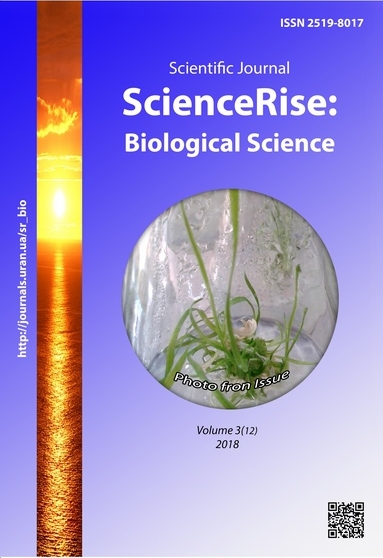Diversity and vitality of tree species in the street plantations of Kryvyi Rih city
DOI:
https://doi.org/10.15587/2519-8025.2018.133186Keywords:
urbanization, tree species, street plantations, diversity, vitality, age categoryAbstract
The important factor of improving the ecological-esthetical role of green plantations in the city environment is a reasoned selection of tree species for greening city territories. That is why there is a necessity to study the state of green plantations in industrial cities. The aim of the work was to study the diversity of dendroflora in city plantations in green plantations of Saksagansky district of Kryvyi Rih city and to reveal decorative species of tree plantations, most resistant to conditions of the urbanized environment. The studies were conducted by the method of inventory of green plantations with defining their type, forest valuation parameters and vitality level. It was established, that the studied territories contain 49 types of tree plants that include 17 families and present 23 genera. By the number of specimens there prevail Aesculus hippocastanum L.(13,4% of the whole number of trees), Populus bolleana Louche (7,8%), Populus nigra L. (6,6%), Ulmus laevis Pall. (6,4%), Tilia cordata Mill. (6,0 %), Robinia pseudoacacia L.(4,1%). The most number of types, characterized with 7-8 points of vitality originates from the Circumboreal floristic region (almost 39% of all species that received highest vitality indices). Fast-growing species prevail in plantations of the studied region, they are 67%. The share participation of middle-growing and slow-growing species is essentially less (23% and 10% respectively). The decrease of vitality of tree plants with age depends on their growth intensity. The decrease of vitality of tree plants is most fast in slow-growing species (in the age after 30 years), and in middle- and fast-growing species after 40-50 years. So, slow-growing tree plants must not be involved into the composition of linear street plantations of the Right-bank Pridneprovie, because they are less long-lived under these conditions. The highest vitality is typical for plants in age categories 21-30 and 31-40 years (27,4% and 22,9% respectively). The most number of trees with the lowest vitality level was revealed among young plants under 10 years old. Species of genera Fraxinus L., Acer L., Populus L., Robinia L.,Ulmus L can be recommended as the most vital among street plantations
References
- Levon, F. M. (2008). Zeleni nasadzhennia v antropohennomu transformovanomu seredovyshchi [Green plantings in anthropogenic transformed environment]. Kyiv: NSC AEI, 364.
- Adinolfi, C., Suarez-Caceres, G. P., Carinanos, P. (2014). Relation between visitors’ behaviour and characteristics of green spaces in the city of Granada, south-eastern Spain. Urban Forestry & Urban Greening, 13 (3), 534–542. doi: http://doi.org/10.1016/j.ufug.2014.03.007
- Jim, C. Y. (2012). Sustainable urban greening strategies for compact cities in developing and developed economies. Urban Ecosystems, 16 (4), 741–761. doi: http://doi.org/10.1007/s11252-012-0268-x
- Avdeeva, E. V. (2008). Zelenyie nasazhdeniya v monitoring okruzhayuschey sredyi krupnogo promyishlennogo goroda: na primere g. Krasnoyarska [Green plantings within the large industrial city environment monitoring: case of Krasnoyarsk]. Krasnoyarsk, 390
- Antonevich, O. A. (2013). Ekologicheskiy monitoring sostoyaniya zelenyih nasazhdeniy urbanizirovannyih territoriy: na primere g. Tomska [Ecological monitoring after state of green plantings in urbanized territories: case of Tomsk city]. Krasnoyarsk, 152.
- Bessonova, V. P., Ponomarova, O. A., Ivanchenko, O. Ie. (2014). Vydove riznomanittia ta zhyttievyi stan derevnykh nasadzhen vzdovzh avtotrasy pivdennoho napriamku m. Dnipropetrovsk [Specific diversity and vital state of tree plantings along the southward direction highway of Dnepropetrovsk city]. Bioindication and ecology issues, 19 (2), 64–84.
- Kuznetsov, S. I., Levon, F. M. (2013). Introduktsiina ta ekoloho-landshaftna optymizatsiia miskykh zelenykh nasadzhen v Ukraini [Introductional and ecological-landscape optimization of urban green plantations in Ukraine]. Kyiv, 95–97.
- Korshikov, I. I. (1996) Adaptatsiya rasteniy k usloviyam tehnogenno zagryaznennoy sredyi [Adaptation of plants to the technogenically polluted environment conditions]. Kyiv: Naukova dumka, 239.
- Lysyi, A. E., Ryzhenko, S. A., Koziaryn, Y. P. et. al. (2009). Ekologicheskie i sotsial'no-gigienicheskie problemy i puti ozdorovleniya krupnogo promyshlennogo regiona [Ecological and social-hygienic problems and ways of sanitation in large industrial region]. Krivoy Rog, 428.
- Tahtadzhyan, A. L. (1978) Floristicheskie oblasti Zemli [Floristic areas of Earth]. Leningrad: Nauka, 248.
- Saveleva, L. S. (1975). Ustoychivost derevev i kustarnikov v zaschitnyih nasazhdeniyah [Stability of trees and bush es in protective plantings]. Moscow: Lesnaya promyshlennost, 271.
Downloads
Published
How to Cite
Issue
Section
License
Copyright (c) 2018 Ivan Korshikov, Lyudmyla Boyko, Oleg Krasnoshtan, Olena Suslova, Antonina Mazur

This work is licensed under a Creative Commons Attribution 4.0 International License.
Our journal abides by the Creative Commons CC BY copyright rights and permissions for open access journals.
Authors, who are published in this journal, agree to the following conditions:
1. The authors reserve the right to authorship of the work and pass the first publication right of this work to the journal under the terms of a Creative Commons CC BY, which allows others to freely distribute the published research with the obligatory reference to the authors of the original work and the first publication of the work in this journal.
2. The authors have the right to conclude separate supplement agreements that relate to non-exclusive work distribution in the form in which it has been published by the journal (for example, to upload the work to the online storage of the journal or publish it as part of a monograph), provided that the reference to the first publication of the work in this journal is included.









